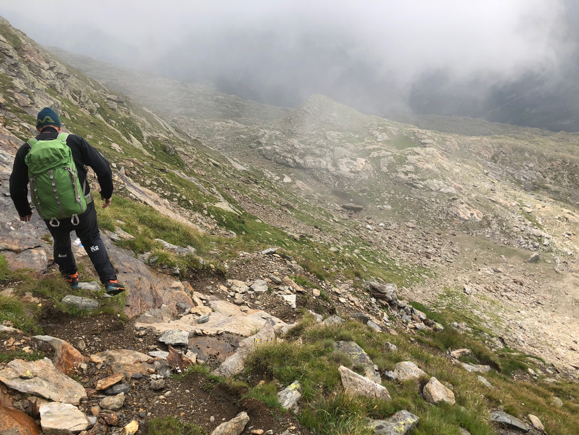MiFID II Risk Profiles: Is it like hiking Alpine mountain trails?

In this blog post I explore MiFID through hiking trails, ending with some reflections on loss aversion. I also argue that we are now only in the MiFID 1.0 era, despite its official name (MiFID II). MiFID will move from ‘compliance driven’ to something more meaningful.
To explain this further, for those of you who occasionally hike in the mountains, you may be familiar with ‘trail rating systems’, indicating their difficulty level. In Switzerland, for instance, they range from T1 (very easy) to T6 (very challenging).
MiFID II is about offering suitable investment advice to retail investors. A crucial element of a suitable portfolio construction is determining the client’s risk profile. There are no clear, legally defined, risk profiles, but in practice between four and ten profiles are typically applied by financial institutions. For instance, six different levels would be a good average and, in that case, Risk Profile 1 (R1) would be very risk averse and R6 highly risky.
The Swiss Trails
This summer, I was hiking in the Swiss alps with some friends. We chose a multiple day hiking trip in Ticino, the lesser known, but beautiful Italian part of this pristine alpine country. There is a colour rating system to inform hikers about the severity of the trail. For instance, red-white means you are safe, these are T1–T3 trails. Whenever the trail colour changes to blue-white, mind your steps; T4–T6 are characterized by a need for mountaineering equipment (although it does not entail ‘true climbing’) and you are exposed. If you, like me, suffer from mild vertigo, T4 is where it starts getting serious.
Before we return to the Swiss Alps, let’s recap for a moment which risk profiles fall under MiFID II. Without going into detail, risk profiles are determined by ‘combining’ your financial capacity, knowledge, experience, and your risk tolerance. The quotation marks refer to the fact that there is no accepted or pre-described framework for combining a subjective and objective outcome. In other words, there is no straightforward mathematical answer.
A key block of MiFID is determining one’s risk tolerance. Several questions (in practice ranging between 5 and 120) are asked to clients to gauge their risk tolerance. There is no specific guideline provided by MiFID on how many questions need to be asked, however there are a few observations on the recommended approach:
- The more questions, the better the insight, provided the right questions are asked.
- Right questions imply consistency and accuracy (but how do you measure that?).
- The questions should not be too few or too many, determining the number of questions is important, five being too few and 120 too many.
- Are all the answers actually used in the portfolio construction? Really?
- Does a dynamic approach make more sense? E.g. should follow-up questions take into account previous answers, social media information, etc.?
- Am I implying that after this version of MiFID a second and third generation will follow?
Often these questions are not scientifically underpinned (apart from in countries like the UK and Canada, where companies like Oxford Risk Management and others have long since developed scientifically tested questionnaires). Furthermore, many of the answers are not used to give suitable advice, certainly not when the assessment is done manually or using algorithms of robo-advisors. But let’s forget about these reflections in the context of this blog and assume that there is a ‘correct’ way of assessing someone’s risk tolerance. MiFID II added or sharpened one particular element of that assessment, namely loss aversion. Most people prefer to avoid losses rather than looking at the potential gains that could be made with respect to the risk. Ex-ante that is… Most investors don’t like a bumpy ride.
Preparations are key before starting your hike. Reputable mountain guides will check at the beginning of a guided hike whether you have done this before, for how long, at which difficulty level, as well as what your physical capabilities are
The regulator—with good reason—wants to ensure that an investor has the financial means to invest and that he/she doesn’t suffer (too much) when that investment goes sour. They want advisors to understand the financial capacity, knowledge & experience of their clients.
The problem is that there are no clear guidelines on how financial institutions should calculate this. However, MiFID refers to income, expenses, assets, debt, and future liquidity needs.
Suffice here to say that ‘determining your financial capability’ is (or should be) an objective assessment. Either you can take the potential loss, or you cannot, albeit oversimplified. Of course, there is a dynamic component to this. Hopefully, your financial capabilities go up over time and not the other way around. But then again, how, and when, are important life events such as job loss and divorce factored in?
MIFID requires that the advisor also checks your knowledge and experience to avoid you investing—or being advised to invest— in something that you don’t understand. Assume you ‘pass the test’. There is no concrete guidance whatsoever on how to combine the objective outcome of your financial capability and the subjective outcome of the risk tolerance assessment into a risk profile, but let’s apply some common sense and agree that such a profile can be reasonably determined.
The Alps Analogy
Now we are getting closer to our alpine trail ranking system. Risk profiles can vary from ‘very risk averse’ to ‘risk takers’, and anything in between. A highly risk averse investor may, for instance, be recommended a bond and cash containing portfolio. Although it is way too simplistic to differentiate a risk profile on the equity/bond/cash percentage alone, typically higher risk portfolios will contain a higher equity component. The highest risk categories could arguably even contain some derivatives and (why not?) investments in start-ups, which are very high-risk capital.
The latter can and should only be done with money you can ‘miss’. Remember our loss aversion element. Of course, what you can afford to lose depends on what you are comfortable with, psychologically (subjective) and financially (objective).
The Swiss T1 trail is our lowest Risk Profile, so let’s compare it to R1. We want to grow our money a bit via some very safe investments over a very long or a shorter period of time. Time horizon is another key parameter entering the equation. Same for the trail. Even if you are hiking an easy route because you don’t like exposure or ‘klettering’, you can still opt for a long six hour plus hike or a more pleasant one-hour walk (let’s not call that a hike anymore).
The Risk Takers, ending up in the highest risk categories (R5 – R10) go for higher returns (higher mountain kicks). Of course! Why incur risk without the possibility of a much higher reward, or a huge loss (There ain't no such thing as a free lunch).
High Risk Takers?
Wait a minute…is a high-risk taker in the physical world also, by definition, a high-risk taker in the money world? Here is where it gets confusing, even when hearing what the experts have to say.
My personal view is that there is not necessarily a positive correlation. For sure, there is no concluding evidence. We will dig into this deeper going forward but just looking at my personal situation: I have so far only invested in stocks, a few ETFs and derivatives, never in bonds and never in mutual funds. So, by definition, without filling out the MiFID questionnaire, I would end up in one of the higher or highest risk profiles. So, an R6–R10 let’s say. And although I love sports, I don’t like things like bungee jumping or delta flying…or hiking T4–T6 trails.
In the July 2018 edition of Swissquote, there was a very interesting article about neuroeconomics, which is an interdisciplinary approach using neuroscience, economics and psychology. In an interview, the father of neuroeconomics, Paul Glimcher, states that the potential link between financial risk taking and other risk taking is a very controversial one.
It reminds me again of the recent summer trail with my mountain guide friend. For him, even a T5 is like a walk in the park. But he would never invest in stocks!
The difference between T4 and the ‘lesser’ T’s
We are back in the Swiss Alps. Most of your life you have—assuming you like to hike or walk—hiked <T4 trails, the red-white ones. Not always easy…the Swiss seem to have a different definition of easy to ours in Belgium. But, in general, although sometimes long, steep and challenging, they are by and large doable and seldom exposed.

I love the mountains and hiking, ski touring etc. but I admittedly have a slight fear of heights. Always looking for endurance challenges, I tried to stay away from these blue-white trail paths, until last summer. A good friend and mountaineer had put together a gentle (his words) hike of four days. Only the third day would be a bit more challenging, he said. Turns out it was a T4 (a piece of cake still for the ‘real guys’) but highly challenging for me. ‘Exposed’ suddenly had a different meaning. It seemed we were centimetres (not metres) away from a very steep and undoubtedly deadly fall in the case of a fall. It also didn’t help that the evening before there had been heavy rainfall and the long, green, tasty grass covering the narrow path didn’t help either. The trail went on for a few kilometres around the mountain range, passing waterfalls and huge rocks before we got the part where the steep climbing began. I was so concentrated on not slipping that I didn’t enjoy the hike at all.

Ex-ante and Ex-post
We arrived in a charming mountain village that suddenly appeared as we came out of the forest, where we had struggled with a steep descent alongside a ravine.
In an instant the alm appeared and then the village. Difficult became easy.
‘So…was this trail really so difficult for you?’ asked my friend. Now we were safe in the village, enjoying the late August sun, seeing the villagers prepare for the celebration of one of the saints, it all seemed easier. Jesus…if I had known that….
Ex-ante, when people are confronted with ‘loss aversion’ questions, do they know themselves well enough? First, the way the question is asked is crucial. For instance, asking if someone can bear a 10% loss versus asking how he/she would feel about losing 100,000 EUR as part of a 1 million EUR investment leads to different results. Few institutions (on continental Europe) use psychometrically tested questions. Common sense is applied.
Let’s assume the right questions are asked. Let’s say that my mountain guide friend was able to gauge that T3 was my real comfort level and that T4 would be a stretch, let alone T5. Ex-ante, I would be pleased. A challenging but doable hike. Ex-post? This dawned on me when I did in fact embark on the T4 hike and afterwards realised it was a stretch, but doable and highly rewarding. Next time I would know that there was only one difficult part on this hike and that I, therefore, just needed to hang on a bit longer and all would be fine, and I would actually enjoy it. So in retrospect, I am happy I went for the stretch as my reward was so much higher.
A slightly different take on trails and the ex-ante and ex-post differences was recently described in an excellent issue of the National Geographic. They argue that there are three types of hikes leading to three different experiences:
- Fun to do and fun to talk about after
For example, a weeklong hike in the winter in Lapland but staying in cosy huts with a sauna instead of tents. - Not fun to do but fun to talk about after (hard but nice)
For example, a two-week mini expedition in Svalbard with pulka, cross-country skis, and tents. - Not fun to do and not fun to talk about after
For example, a long horizontal stroll with too many other people.
MiFID requires ‘suitable’ advice. Although I have no proof for this, it seems like the risk and compliance officers are (sometimes gently, sometimes not so gently) pushing us towards the ‘safe side’—the regulator as well. And of course, we don’t want a repeat of the ‘The Big Crisis’. Of course, the spirit of MiFID is correct.
But I dare to question whether enough risk is taken. Is this blasphemy?
Perhaps, but people and society at large tend to overcompensate.
So what exactly have people lost, and on what scale? The stories that emerge are single stock investments in certain popular (banking) stocks. Surely most advisors worth their salt would have advised against single stock investments?
I have heard many other stories along the lines of:
- “I feel ripped off by the high and non-transparent costs.”
- “I paid a huge fee for what?”
- “My savings account had a higher return than my fund investments.”
There is no way this is ‘suitable advice’. Yes, they didn’t lose their money, but the feeling of being ripped off is clearly there and the opportunity cost was huge. Imagine a robo-advisor service which actually does use the input on questions asked and is able to estimate a more appropriate risk profile, the likelihood is high that at least a 3–6% return would have been achieved. Start calculating compounded interest over 20–30 years…
Concluding Thoughts
- MiFID has the right intentions and as a concept makes a lot of sense, but the practical implementation has room for improvement for a much deeper (and scientifically supported) insight over the coming years.
- Just like a T4 is not the same for everybody, risk profiles depend significantly (sometimes entirely) on the right profiling.
- Ex-ante and ex-post are indeed two different things.
- Ex-post one can think, ‘Should I not have gone for a T4? Have I challenged myself enough? Did I take enough risk?’
- Private banks as well will be significantly challenged and will need to enter the digital and more transparent era. But the private banker will remain an important person in the context of 'trust' and deeply understanding a client's needs and context. But one can and should reflect on whether the advisor in the branch has the right qualifications/training/expertise to conduct a quasi-psychological review. And as Kahneman implied: We are all subject to biases.




